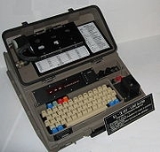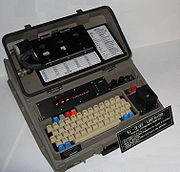
KL-51
Encyclopedia

Encryption
In cryptography, encryption is the process of transforming information using an algorithm to make it unreadable to anyone except those possessing special knowledge, usually referred to as a key. The result of the process is encrypted information...
system that read and punched paper tape for use with teleprinter
Teleprinter
A teleprinter is a electromechanical typewriter that can be used to communicate typed messages from point to point and point to multipoint over a variety of communication channels that range from a simple electrical connection, such as a pair of wires, to the use of radio and microwave as the...
s. It was developed by the U.S. National Security Agency
National Security Agency
The National Security Agency/Central Security Service is a cryptologic intelligence agency of the United States Department of Defense responsible for the collection and analysis of foreign communications and foreign signals intelligence, as well as protecting U.S...
in the 1980s to replace the earlier KL-7
KL-7
The TSEC/KL-7, code named ADONIS and POLLUX, was an off-line non-reciprocal rotor encryption machine. The KL-7 had eight rotors to encrypt the text, seven of which moved in a complex pattern, controlled by notched rings. The non-moving rotor was in fourth from the left of the stack. The encrypted...
, but used digital electronics for encryption instead of rotors
Rotor machine
In cryptography, a rotor machine is an electro-mechanical device used for encrypting and decrypting secret messages. Rotor machines were the cryptographic state-of-the-art for a prominent period of history; they were in widespread use in the 1920s–1970s...
. As of 2006, the U.S. Navy was developing plans to replace KL-51 units still in use with a unit based on a more modern Universal Crypto Device. http://www.dtic.mil/descriptivesum/Y2007/Navy/0303140N.pdf

